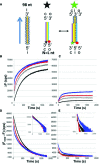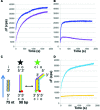ATP hydrolysis provides functions that promote rejection of pairings between different copies of long repeated sequences
- PMID: 28854739
- PMCID: PMC5737215
- DOI: 10.1093/nar/gkx582
ATP hydrolysis provides functions that promote rejection of pairings between different copies of long repeated sequences
Abstract
During DNA recombination and repair, RecA family proteins must promote rapid joining of homologous DNA. Repeated sequences with >100 base pair lengths occupy more than 1% of bacterial genomes; however, commitment to strand exchange was believed to occur after testing ∼20-30 bp. If that were true, pairings between different copies of long repeated sequences would usually become irreversible. Our experiments reveal that in the presence of ATP hydrolysis even 75 bp sequence-matched strand exchange products remain quite reversible. Experiments also indicate that when ATP hydrolysis is present, flanking heterologous dsDNA regions increase the reversibility of sequence matched strand exchange products with lengths up to ∼75 bp. Results of molecular dynamics simulations provide insight into how ATP hydrolysis destabilizes strand exchange products. These results inspired a model that shows how pairings between long repeated sequences could be efficiently rejected even though most homologous pairings form irreversible products.
© The Author(s) 2017. Published by Oxford University Press on behalf of Nucleic Acids Research.
Figures







Similar articles
-
Appropriate initiation of the strand exchange reaction promoted by RecA protein requires ATP hydrolysis.J Mol Biol. 2001 May 25;309(1):29-43. doi: 10.1006/jmbi.2001.4753. J Mol Biol. 2001. PMID: 11491297
-
Three mechanistic steps detected by FRET after presynaptic filament formation in homologous recombination. ATP hydrolysis required for release of oligonucleotide heteroduplex product from RecA.Biochemistry. 1998 Aug 18;37(33):11692-706. doi: 10.1021/bi980646s. Biochemistry. 1998. PMID: 9709007
-
The ATPase activity of RecA is needed to push the DNA strand exchange through heterologous regions.EMBO J. 1991 Dec;10(13):4391-6. doi: 10.1002/j.1460-2075.1991.tb05017.x. EMBO J. 1991. PMID: 1836761 Free PMC article.
-
Motoring along with the bacterial RecA protein.Nat Rev Mol Cell Biol. 2007 Feb;8(2):127-38. doi: 10.1038/nrm2099. Epub 2007 Jan 17. Nat Rev Mol Cell Biol. 2007. PMID: 17228330 Review.
-
Homologous genetic recombination as an intrinsic dynamic property of a DNA structure induced by RecA/Rad51-family proteins: a possible advantage of DNA over RNA as genomic material.Proc Natl Acad Sci U S A. 2001 Jul 17;98(15):8425-32. doi: 10.1073/pnas.111005198. Proc Natl Acad Sci U S A. 2001. PMID: 11459985 Free PMC article. Review.
Cited by
-
The positioning of Chi sites allows the RecBCD pathway to suppress some genomic rearrangements.Nucleic Acids Res. 2019 Feb 28;47(4):1836-1846. doi: 10.1093/nar/gky1252. Nucleic Acids Res. 2019. PMID: 30544167 Free PMC article.
-
Slow extension of the invading DNA strand in a D-loop formed by RecA-mediated homologous recombination may enhance recognition of DNA homology.J Biol Chem. 2019 May 24;294(21):8606-8616. doi: 10.1074/jbc.RA119.007554. Epub 2019 Apr 11. J Biol Chem. 2019. PMID: 30975899 Free PMC article.
-
Weaving DNA strands: structural insight on ATP hydrolysis in RecA-induced homologous recombination.Nucleic Acids Res. 2019 Sep 5;47(15):7798-7808. doi: 10.1093/nar/gkz667. Nucleic Acids Res. 2019. PMID: 31372639 Free PMC article.
-
Divalent metal cofactors differentially modulate RadA-mediated strand invasion and exchange in Saccharolobus solfataricus.Biosci Rep. 2023 Feb 27;43(2):BSR20221807. doi: 10.1042/BSR20221807. Biosci Rep. 2023. PMID: 36601994 Free PMC article.
-
Moving forward one step back at a time: reversibility during homologous recombination.Curr Genet. 2019 Dec;65(6):1333-1340. doi: 10.1007/s00294-019-00995-7. Epub 2019 May 23. Curr Genet. 2019. PMID: 31123771 Free PMC article. Review.
References
-
- Roca A.I., Cox M.M.. RecA protein: Structure, function, and role in recombinational DNA repair. Prog. Nucleic Acid Res. Mol. Biol. 1997; 56:129–223. - PubMed
-
- Kowalczykowski S.C., Eggleston A.K.. Homologous pairing and DNA strand exchange. Annu. Rev. Biochem. 1994; 63:991–1043. - PubMed
-
- Roca A.I., Cox M.M.. The RecA protein: structure and function. Crit. Rev. Biochem. Mol. Biol. 1990; 25:415–456. - PubMed
MeSH terms
Substances
LinkOut - more resources
Full Text Sources
Other Literature Sources
Molecular Biology Databases

